Post-war use of German 75 and 150 mm infantry guns
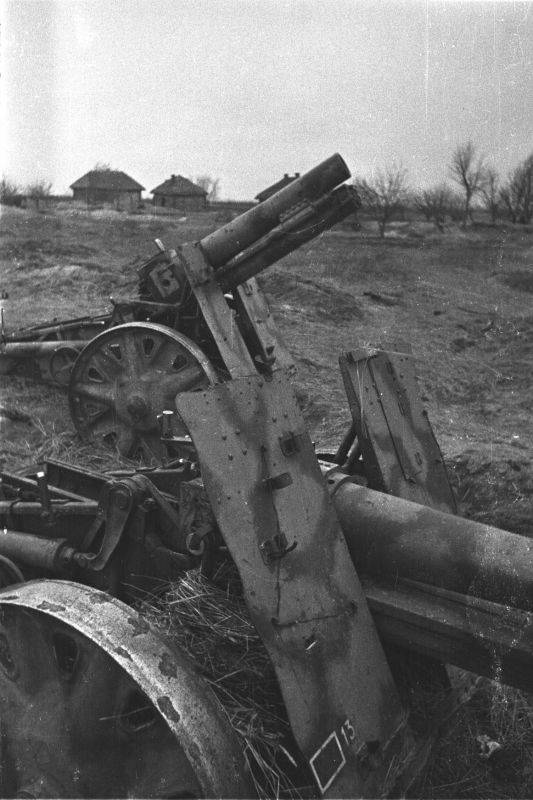
As is known, in the initial period of the war the German armed forces did not have 120 mm mortars. But this does not mean that the German infantry did not have artillery fire support capable of effectively destroying field fortifications and making passages in barbed wire.
Unlike the Red Army, the German infantry regiments were not equipped with 120 mm mortars, but with heavy 150 mm 15 cm sIG guns. 33, capable of firing both direct fire and along a steep overhead trajectory. Lighter and more maneuverable means of fire support for the regimental level were the 75-mm 7,5 cm le.IG.18 infantry guns, which also had howitzer characteristics.
In the post-war period, these artillery systems, despite their obsolescence, remained in service in a number of countries until the mid-1950s.
75 mm infantry gun 7,5 cm le.IG.18
In the armed forces of Nazi Germany, the 75-mm gun 7,5 cm le.IG.18 (German: 7,5 cm leichtes Infanteriegeschütz 18 - 7,5 cm light infantry gun model 18) was very common, which fought from the first until the last days of the war. This light artillery system, created in 1927 by Rheinmetall-Borsig AG and designed for direct artillery support of infantry, is considered one of the best in its class.
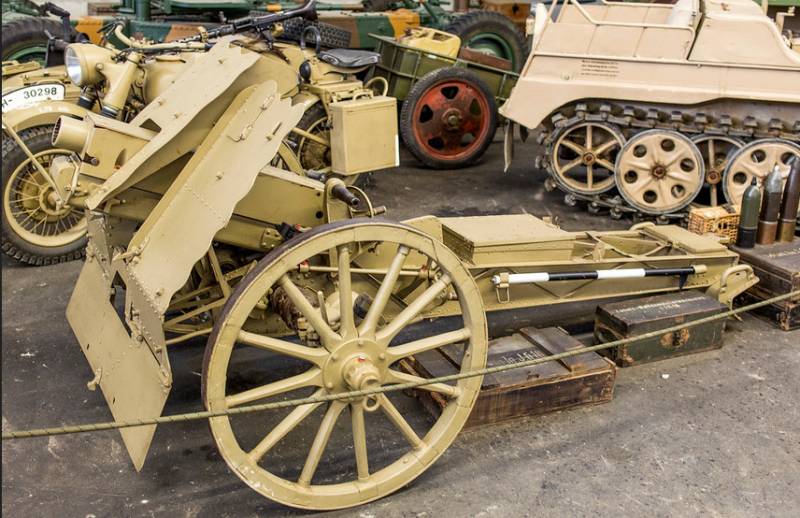
75-mm infantry gun 7,5 cm le.IG.18 on display at the museum
The main purpose of the 7,5 cm le.IG.18 was the destruction of openly located and hidden enemy personnel, as well as the suppression of enemy firing points, field artillery and mortars. If necessary, a 75-mm infantry gun could fight enemy armored vehicles.
Unlike the regimental guns available in the armies of other countries, the German 7,5 cm le.IG.18 infantry gun could fire at a very large elevation angle (from −10 to +75°) and had separate case loading with various propellant loads. charge.
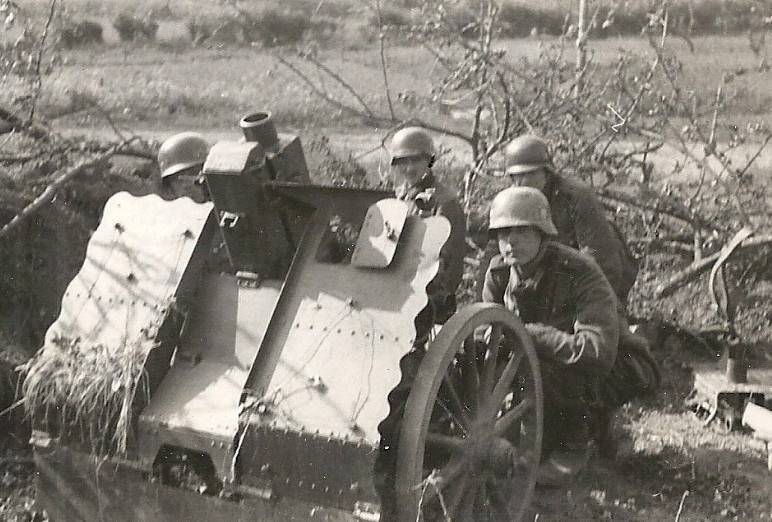
Light infantry 75-mm gun 7,5 cm le.IG.18 with a maximum elevation of the barrel
Thanks to this feature, it was possible to choose the flight path of a projectile and hit visually unobservable targets hidden in folds of the terrain and on the reverse slopes of hills, due to which the weapon was highly effective and flexible in use. In fact, the German 75 mm infantry gun could be used as a Russian 76,2 mm regimental gun for firing at visually observed targets and as a light howitzer.
The weight of the 7,5 cm le.IG.18 gun in firing position was 400 kg, thanks to which a six-man crew could roll it quite freely over short distances. If necessary, special straps were used.
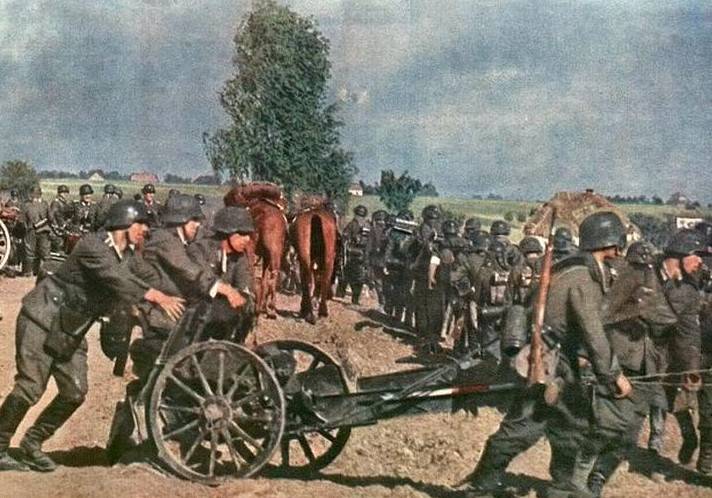
Weight in stowed position with front end – 1560 kg. The gun had a shield cover, consisting of a 4,5 mm thick fixed shield riveted to the front of the machine (with a folding lower shield) and a movable shield (3 mm thick) mounted on the front of the cradle. Sights consisted of a swinging sight with an independent aiming line and panorama.
With a barrel length of 885 mm (11,8 calibers), the initial speed of a 7,5 cm Igr.18 high-explosive fragmentation projectile weighing 6 kg, depending on the propellant charge, could vary from 92 to 212 m/s. The table firing range at the optimal elevation of the firing barrel on charge No. 1 was 810 m, and on charge No. 5 – 3470 m. Rate of fire – 12 rounds/min.
The ammunition included two types of high-explosive fragmentation shells and two types of cumulative shells, as well as target designation shells. The 7,5 cm Igr.18 high-explosive fragmentation projectile was loaded with a charge of cast TNT weighing 700 g, in which, for better ability to adjust the fire, there was a capsule with red phosphorus, which gave a clearly visible column of smoke upon explosion. Projectile 7,5 cm Igr. 18 Al was different in that its explosive charge consisted of cast ammonal with the addition of aluminum powder.
A high-explosive fragmentation projectile could penetrate wood-earth field fortifications with a floor thickness of up to 1 m or a brick wall up to 25 cm thick and had a good fragmentation effect. When a shell exploded, the affected area was 12 m to the sides, 6 m forward and 3 m back. When a shell exploded after a ricochet at a height of up to 10 m, the affected area was 15 m to the sides, 10 m forward and 5 m back.
The gun's ammunition did not contain caliber armor-piercing shells, but, as practice has shown, firing high-explosive fragmentation shells on powder charge No. 5, with the fuse set to slow down, made it possible to penetrate armor 20-22 mm thick. Thus, at a minimum firing distance, the le.IG.18 cannon could fight armored vehicles that had bulletproof armor.
At the same time, combat tests of the 75-mm gun in Spain showed that in order to combat more protected tanks cumulative projectiles are needed. Such ammunition, known as 7,5 cm Igr.38 and 7,5 cm Igr.38HL/A, was developed in 1938. The armor penetration of a cumulative projectile loaded with 530 g of TNT alloy with hexogen was 85-90 mm normal. Taking into account the large angle of inclination of the frontal armor of the T-34 tank, this was not always enough. But even in the case of penetration, the armor-plated damaging effect of the cumulative jet was weak in most cases. With a reasonable degree of probability, it was possible to hit the “thirty-four” with a cumulative projectile only on the side. In addition, the anti-tank capabilities of the le.IG.18 gun were reduced by the limited horizontal aiming sector (11°), which made it difficult to fire at fast-moving targets. With an initial velocity of the cumulative projectile of 260 m/s, the effective firing range did not exceed 400 m.
The ammunition also included a projectile with a 7,5 cm Igr.Deut remote tube, which was intended to create a clearly visible landmark on the ground. The design of this projectile was unusual, and it did not contain high explosives. To indicate the point of impact, 120 brick-colored cardboard circles and 100 red cardboard circles were thrown onto the ground using an expelling charge. There was also a projectile with a smoke-generating composition.

The first modification, adopted for service in 1932, was intended for horse-drawn transportation and had wooden wheels with a metal rim and switchable suspension.
In 1937, production of the 7,5 cm le.IG.18 Mot gun with metal disc wheels equipped with pneumatic tires began. In this case, it was possible to tow by vehicles at speeds of up to 50 km/h.
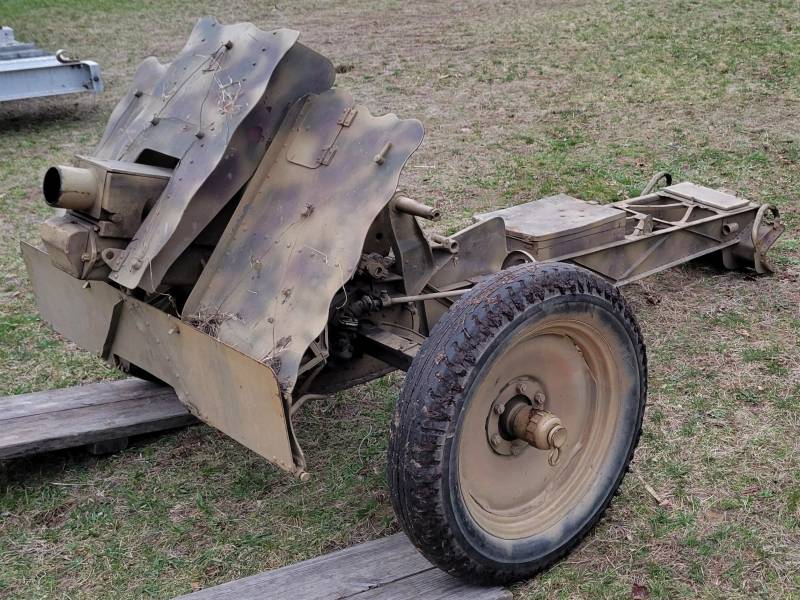
The Wehrmacht and SS infantry units were very well equipped with 7,5 cm le.IG.18 guns. According to the 1940 staffing schedule, the Wehrmacht infantry division had 20 light infantry guns. Cavalry divisions were entitled to 28 guns, motorized divisions - 16 guns per division. In light divisions (formed since 1941 for operations on rough terrain), each infantry battalion had a support company consisting of 6 81-mm mortars and 2 light infantry guns (a total of 12 guns in the division). The grenadier regiments of the tank divisions had 2 light infantry guns in each battalion, as well as 4 light infantry guns in the regimental infantry gun company. The motorcycle (later reconnaissance) battalion of the tank divisions had 2 more light infantry guns. In total, the Wehrmacht tank division had 22 light guns. In offensive operations, 7,5 cm le.IG.18 guns were transferred to battalions (two per battalion), and, if necessary, to a company.
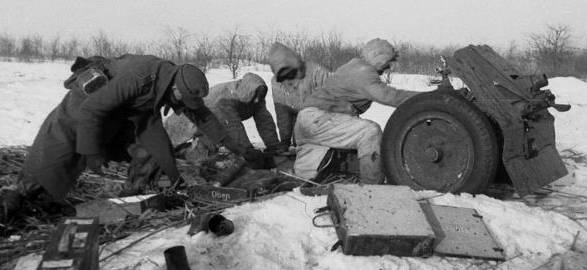
As of September 1, 1939, the troops had 2933 light infantry guns and 3506 thousand rounds of ammunition for them. On June 1, 1941, the German armed forces had 4176 light infantry guns and 7956 thousand rounds of ammunition for them. On March 1, 1945, the enemy had 2594 le.IG.18 units, which were actively used until the surrender of the Third Reich.
The consumption of ammunition was very intensive. In 1942, they used 6200 thousand rounds, in 1943 - 7796 thousand, in 1944 - 10 thousand, and in January - February 817 - 1945 thousand rounds.
In addition to the Rheinmetall-Borsig AG concern, the Habamfa company (Ammendorf) produced the 75-mm light infantry gun le.IG.18, and after the occupation of the Czech Republic, weapons Bohmische Waffenfabrik concern (as the Germans called the Czechoslovak concern CZ in Strakonice).
75-mm le.IG.18 guns often operated directly in the combat formations of infantry units, and therefore their losses were very significant. For example, in the period from December 1, 1941 to February 28, 1942, 510 guns of this type were lost, and from October 1944 to February 1945 - 1131 guns. A significant part of the guns lost by the Germans went to the Red Army.
The first 7,5 cm le.IG.18 were captured by the Red Army in the summer of 1941. However, a noticeable number of such guns and ammunition for them were captured at the end of 1941 - beginning of 1942, during the counter-offensive of the Red Army near Moscow.
In 1942-1943. up to one and a half hundred captured 75-mm infantry guns were sent to form artillery batteries (4-5 guns each) attached to rifle, motorized rifle and cavalry regiments. German-made guns were often used in parallel with Soviet 76-mm regimental guns of the 1927 model.
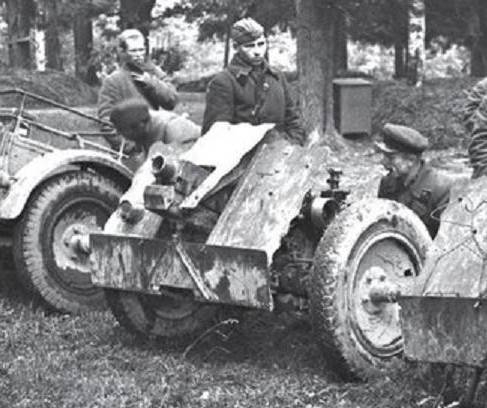
At the first stage of use in the Red Army, the 75-mm le.IG.18 guns were primarily fired directly. This was due to the fact that mounted shooting was difficult to master for insufficiently trained personnel, and for effective firing from closed positions, gun commanders and crews required good knowledge of the materiel and shooting techniques. But already in 1943, the GAU produced for the “75-mm German light infantry gun mod. 18" shooting tables and operating instructions, translated into Russian.
In total, during the Great Patriotic War, our troops captured about 1000 serviceable 7,5 cm le.IG.18 guns, a significant part of which were used against their former owners. In the post-war period, the USSR transferred several hundred 7,5 cm le.IG.18 to the armed forces of friendly states.
For example, after the formation of the German Democratic Republic, 75-mm infantry guns were used in the process of training the barracks people's police, which later became the nucleus of the National People's Army of the GDR.
After the end of World War II, 7,5 cm le.IG.18 guns were available in the armed forces of Albania, Bulgaria, Spain, Czechoslovakia and Yugoslavia. In some countries, despite their obsolescence, they were used or stored until the early 1960s
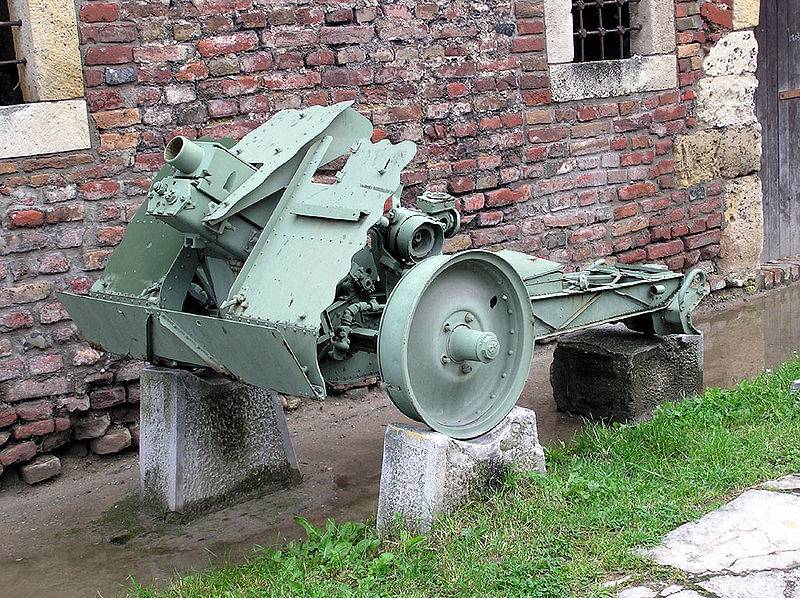
75 mm infantry gun 7,5 cm le.IG.18 in the Military Museum in Belgrade
Apparently, among European countries, 75-mm German-made guns were in service for the longest time in Albania, Yugoslavia and Spain.
Even before the start of World War II, as part of military-technical cooperation with Germany, the Chinese government acquired a large batch of 75-mm infantry guns, which were actively used against the Japanese invaders, and then in the civil war between the Kuomintang and the CPC.
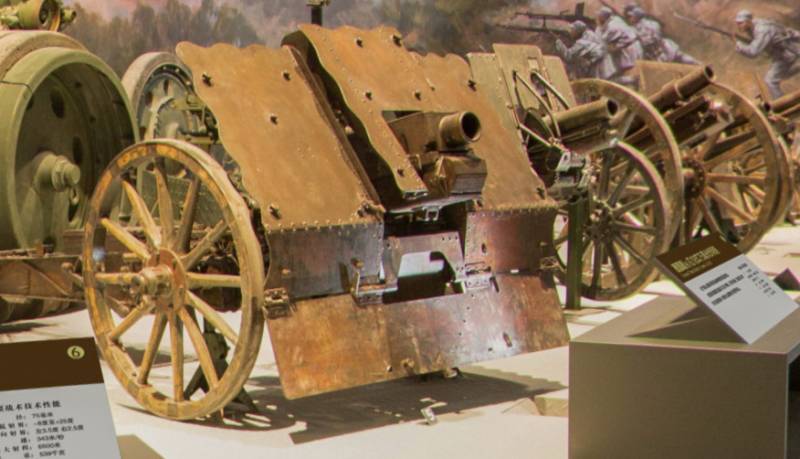
75-mm infantry gun 7,5 cm le.IG.18 on display at the Military Museum of the Chinese Revolution
After the victory over Nazi Germany, the USSR transferred a large batch of captured 7,5 cm le.IG.18 infantry guns and ammunition to the communist People's Liberation Army of China, which was waging an armed struggle against the Kuomintang forces.
Subsequently, several dozen 75-mm guns made in Germany were used by Chinese people's volunteers during the fighting in Korea. Due to its lighter weight and the ability to be mounted, the 75-mm infantry gun was better suited for the specific conditions of the Korean Peninsula than the much heavier Soviet 76,2-mm regimental gun mod. 1943
Heavy infantry 150 mm gun 15 cm sIG. 33
A unique feature of the German regimental artillery during World War II was that, in addition to the light 75 mm 7,5 cm le.IG.18 guns, it was equipped with heavy 150 mm 15 cm sIG guns. 33 (German 15 cm schweres Infanterie Geschütz 33 - 15 cm heavy infantry gun model 33 g).
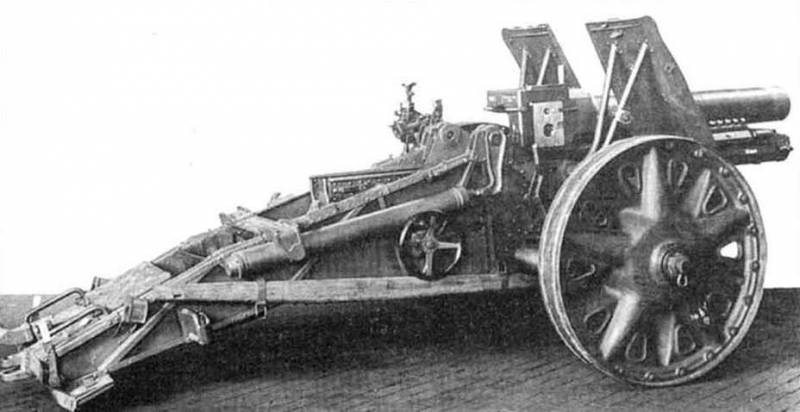
150 mm heavy infantry gun 15 cm sIG. 33 on a horse-drawn carriage
The development of the 150-mm gun was carried out by the Rheinmetall-Borsig AG concern on its own initiative in the 1920s. For several years, this artillery system failed to interest the German military, who considered it too heavy for a regimental level. With a high probability, the heavy infantry gun would not have been accepted into service in Germany if not for the Soviet order - on August 28, 1930, an agreement was concluded with the Butast company (a front office of the Rheinmetall concern) for the supply of eight 150-mm mortars ( this is how this gun was classified in the USSR), converted to 152,4 mm caliber, and transfer of documentation for production.
The German gun was adopted by the Red Army under the designation “152-mm mortar mod. 1931", in production documents it often appeared as "NM" ("German mortar"). In 1932-1935, the Putilov plant produced a small batch of these guns; in total, the Red Army had a little more than a hundred 152-mm mortars. In accordance with the artillery armament system of the Red Army, the 152-mm mortar belonged not to regimental, but to divisional artillery.
After the Rheinmetall-Borsig AG concern received money from the USSR, large-scale shooting events were organized at the training ground, and German generals decided that the 150 mm gun had value, and it was adopted by the Reichswehr in 1933.
The gun contained, by the standards of the mid-1930s, a number of archaic technical solutions, but overall had very good characteristics. The maximum elevation angle was 73° - that is, the gun was a full-fledged howitzer.
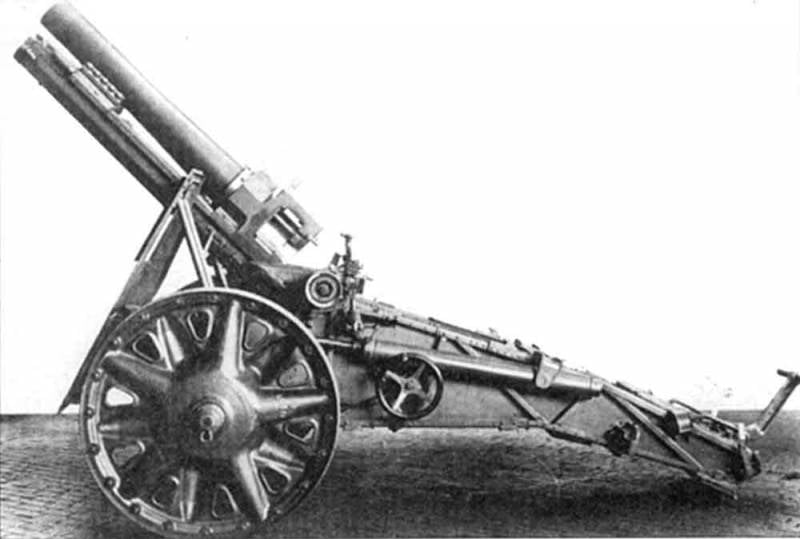
The range of horizontal aiming angles, despite the simple single-beam carriage, was also quite large - 11,5° to the right and left.
The gun was produced in two versions: for mechanized and horse-drawn traction. Horse traction was usually used in artillery companies attached to infantry regiments. In the stowed position, the version for horse traction weighed 1700 kg, for mechanical traction - 1825 kg.
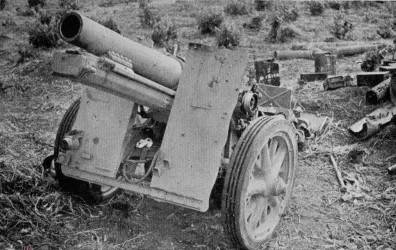
For a 150-mm caliber, the gun turned out to be relatively light, but operation in a regimental unit required further reduction in weight. At the end of the 1930s, designers from Rheinmetall-Borsig AG made an attempt to lighten the gun, partially replacing steel with light alloys. After which the structure became lighter by about 150 kg. However, due to the shortage of light metals after the outbreak of World War II, the production of cast aluminum alloy carriages was discontinued.
The standard means of towing the sIG 33 in motorized and tank divisions was the 3-ton Sd.Kfz half-track tractor. eleven.
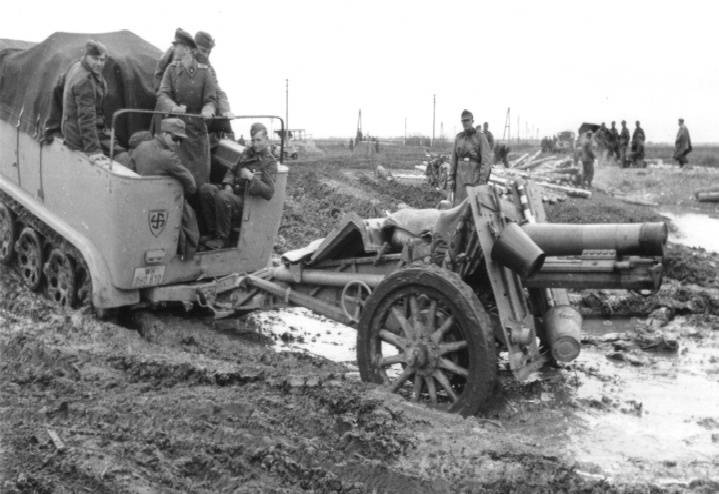
In the first case, cast light-alloy wheels with steel edgings had rubber tires, and the speed of towing by a horse-drawn cart did not exceed 12 km/h. Torsion bar suspension allowed mechanical towing at a speed of 35 km/h.
Together with 15 cm sIG. 33 often used captured tractors: the French Unic P107 and the Soviet Komsomolets.
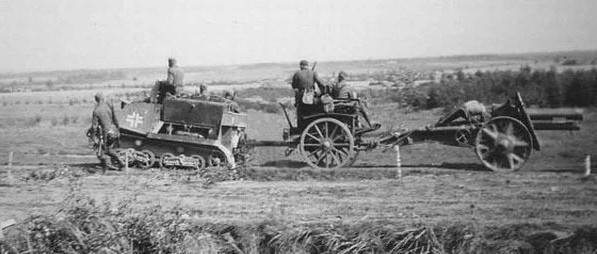
Most often, captured tractors were used to tow guns that were originally designed for horse traction.
The piston-breech gun fired shots with separate cartridge loading. The crew, consisting of seven people, could provide fire at a rate of fire of up to 4 rounds/min.
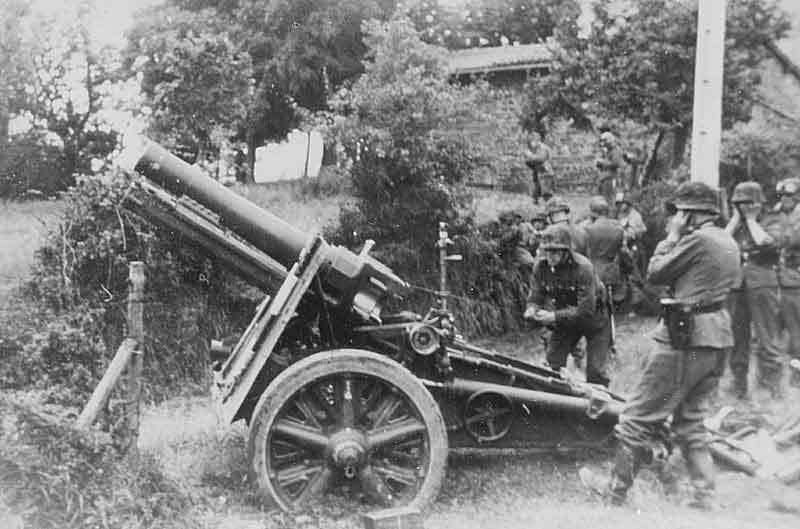
The ammunition load included a wide range of shells. High-explosive fragmentation grenades 15 cm IGr were considered the main ones. 33 and 15 cm IGr. 38 weighing 38 kg, containing 7,8-8,3 kg of TNT or amatol. When the fuse was set to instant action, the lethal fragments scattered 20 m forward, 40-45 m to the side and 5 meters back. The high-explosive effect of the shells was more than enough to destroy light field fortifications. The shells penetrated shelters up to three meters thick made of earth and logs.
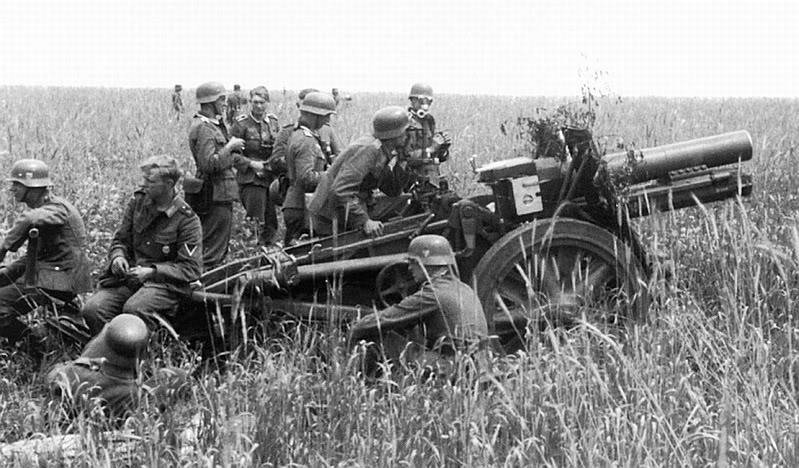
Casings made of steel or brass, in addition to the main powder charge, contained up to six weighted bundles of diglycol or nitroglycerin gunpowder. When firing 15 cm IGr shells. 33 and 15 cm IGr. 38 on the 1st (minimum) charge the initial speed was 125 m/s, the maximum firing range was 1475 m. On the 6th (maximum) charge it was 240 m/s and 4700 m, respectively.
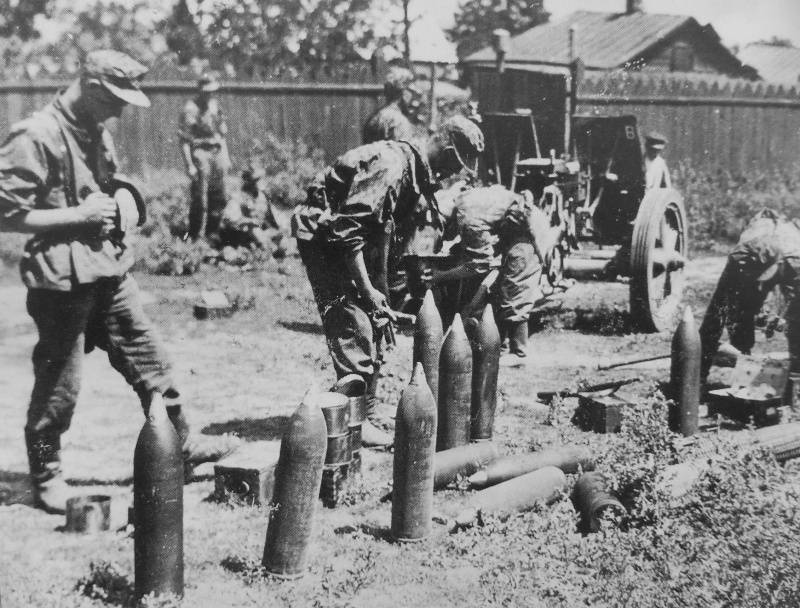
The IGr38 Nb smoke projectile, weighing 40 kg, created a smoke cloud with a diameter of about 50 m, the average smoke time was 40 s.
Incendiary shell 15 cm IGr. 38 Br was loaded with thermite segments, which were scattered over the terrain with an expelling powder charge.
Although during the Second World War there was no tank capable of maintaining combat effectiveness after being hit by a high-explosive fragmentation projectile weighing 38 kg, containing about 8 kg of powerful explosives, in 1941, the 15 cm sIG ammunition was hit. 33 introduced a 15 cm IGr cumulative projectile. 39 HL/A with armor penetration along the normal 160 mm. With a mass of 24,6 kg, the projectile was loaded with 4,14 kg of TNT alloy with hexogen. The tabulated firing range was 1800 m, the effective range was no more than 400 m.
Since 1942, Stielgranate 150 over-caliber finned mines began to be used for shooting from 42-mm guns, which to some extent was intended to compensate for the lack of heavy mortars in the Wehrmacht. In domestic literature, it is customary to speak condescendingly about this ammunition. But in reality, in the right conditions and when used correctly, a 300 mm high explosive mine weighing 90 kg, containing 54 kg of ammatol, with a firing range of just over 1000 m, could be very effective.
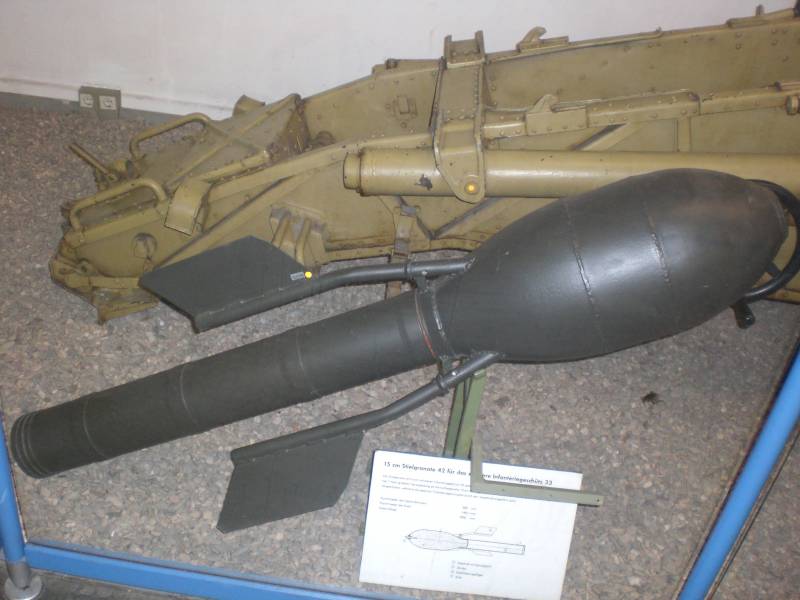
In particular, this ammunition was successfully used to clear wire fences and minefields, as well as against long-term defensive structures. In terms of destructive effect, the Stielgranate 42 over-caliber mine was approximately equivalent to the Soviet OFAB-100 aerial bomb, the explosion of which created a crater with a diameter of 5 m and a depth of 1,7 m.
According to the standards of 1940, an artillery company of an infantry regiment was supposed to have 6 light 7,5 cm le.IG.18 guns and two heavy 15 cm sIG guns. 33. In total, the infantry division had 6 heavy infantry guns. In September 1939, the Wehrmacht had over 400 15 cm sIG guns. 33. By June 1, 1941, the Wehrmacht had 867 heavy infantry guns and 1264 thousand shells for them. In March 1945, 1539 15 cm sIG heavy infantry guns were in service. 33. In total, German industry produced approximately 4600 guns.
The use of 150 mm guns in German infantry regiments was an unprecedented step. During the Second World War, no other army had such powerful artillery systems in its infantry units. The firepower of these guns gave the German infantry a tangible advantage on the battlefield and allowed them to independently solve tasks for which divisional artillery had to be used in the armies of other countries.
The regiment commander had the opportunity to use his “own” artillery to hit targets that were inaccessible to machine guns and mortars. Platoons of light 75-mm infantry guns could be assigned to battalions. Heavy 150 mm guns were always used at the regimental level.
Infantry guns were placed in close proximity to the front line, which during offensive operations reduced reaction time and made it possible to suppress exposed targets as quickly as possible. At the same time, 15 cm sIG guns. 33 had a relatively short firing range and could not effectively conduct counter-battery combat, as a result of which they often suffered losses. In case of a rapid retreat, evacuate the heavy 150 mm sIG guns. 33 was more difficult than the 75 mm le.IG.18, as a result of which they were often captured by the enemy.

The Red Army managed to capture several hundred German 150 mm infantry guns and a significant amount of ammunition for them. Initially, they were used unorganized, as a supernumerary means of fire reinforcement for regiments and divisions. As in the case of 75-mm light infantry guns, at the first stage fire was carried out only at visually observable targets, since mounted firing from heavy infantry guns required a good knowledge of the characteristics of charges, the properties of ammunition and their markings.
To enable the full use of 150 mm guns, firing tables and operating instructions were issued in 1942, and crews received the necessary training. After that, captured 15 cm sIG. 33 began to replace 122-mm howitzers in some mixed artillery battalions of artillery regiments attached to rifle divisions.
However, such a replacement in divisional level artillery cannot be considered optimal. The power of the 150-mm projectile was, of course, higher, but in terms of range the 150-mm heavy infantry gun was inferior not only to the new 122-mm M-30 howitzer, but also to the modernized 122-mm mod. 1909/37 and 122 mm mod. 1910/30
Despite the low firing range, 150-mm guns of German production were used by the Red Army until the last days of the war. Their best qualities were manifested during offensive operations, in those cases when it was required to suppress the well-fortified centers of enemy resistance.
In 1944, units of the Yugoslav People's Army captured approximately two dozen 150 mm sIG guns. 33, and they fired very successfully at the Germans and Croats in a number of offensive operations. After the end of World War II, captured heavy infantry guns were used by the JNA until the early 1950s.
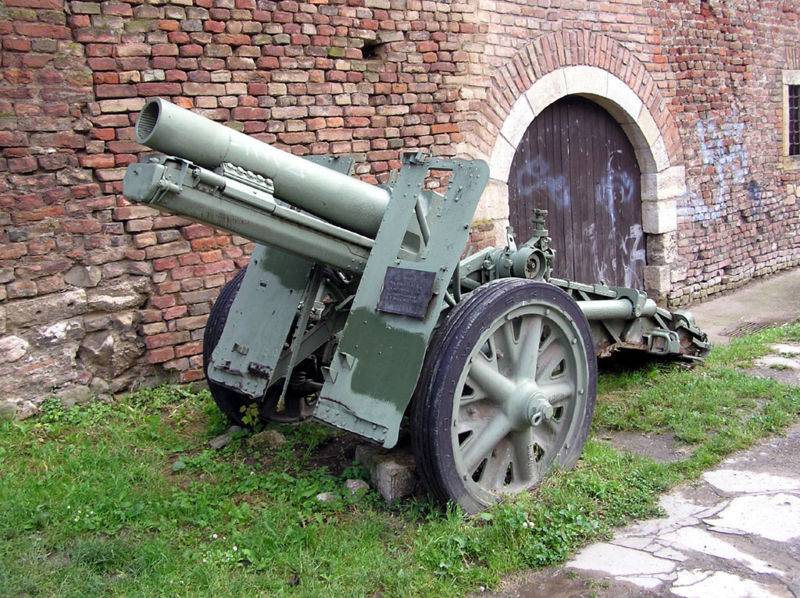
150 mm heavy infantry gun 15 cm sIG. 33 at the Military Museum in Belgrade
On the Western Front, several hundred 150 mm sIG guns became trophies of the British and Americans. 33, which in the post-war period were partially transferred to the armed forces of the states liberated from the Nazis.
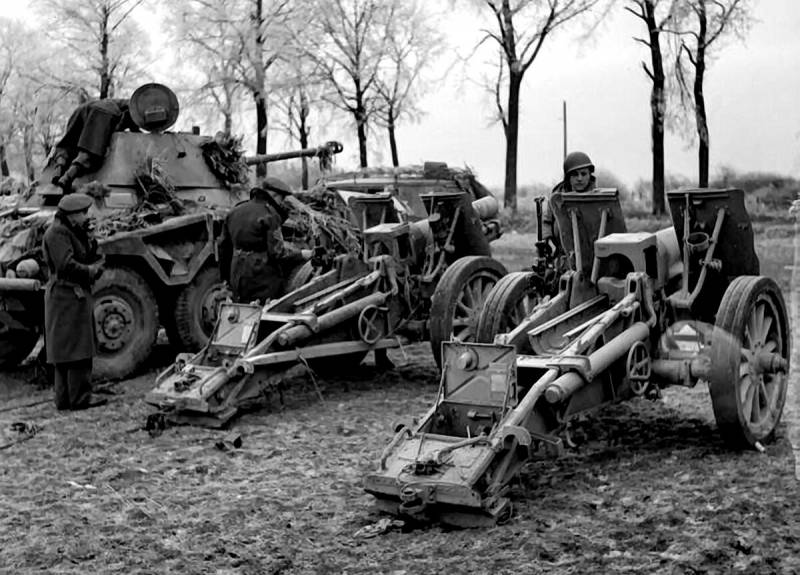
American soldiers inspect 150 mm sIG guns. 33 among other captured German equipment
However, due to the short firing range and outdated design of the 15 cm sIG gun. 33 by the mid-1950s almost everywhere left artillery parks.
There is information that the guns are 15 cm sIG. 33 in the 1930-1940s were used by Kuomintang troops in the Sino-Japanese War. A number of sources indicate that they could also have been used in the early 1950s in hostilities on the Korean Peninsula, but archival or photographic materials confirming this could not be found.
Продолжение следует ...
Information